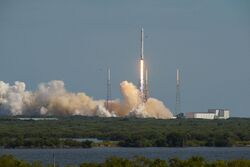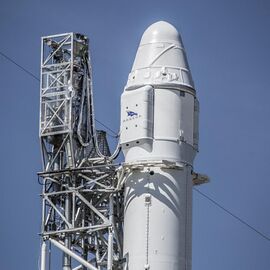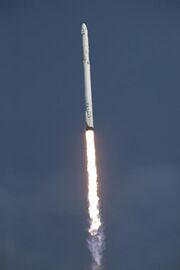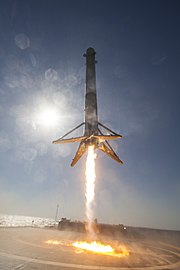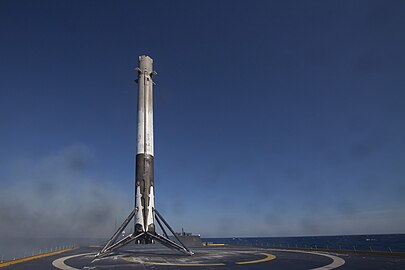Engineering:SpaceX CRS-8
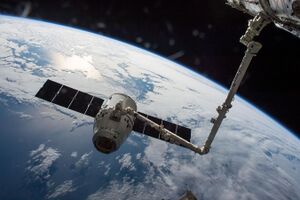 The CRS-8 SpaceX Dragon captured by Canadarm on April 10, 2016 | |
| Mission type | ISS resupply |
|---|---|
| Operator | SpaceX / NASA |
| COSPAR ID | 2016-024A |
| SATCAT no. | 41452 |
| Mission duration | 32 days, 21 hours, 48 minutes |
| Spacecraft properties | |
| Spacecraft | Dragon C110 |
| Spacecraft type | Dragon CRS |
| Manufacturer | SpaceX |
| Start of mission | |
| Launch date | April 8, 2016, 20:43 UTC |
| Rocket | Falcon 9 FT[1] |
| Launch site | Cape Canaveral Air Force Station SLC-40 |
| Contractor | SpaceX |
| End of mission | |
| Disposal | Recovered |
| Landing date | May 11, 2016, 18:31 UTC[2] |
| Landing site | Pacific Ocean[2] |
| Orbital parameters | |
| Reference system | Geocentric |
| Regime | Low Earth |
| Perigee altitude | 402 km (250 mi) |
| Apogee altitude | 405 km (252 mi) |
| Inclination | 51.64 degrees |
| Period | 92.63 minutes |
| Epoch | May 10, 2016, 13:19:38 UTC |
| Berthing at ISS | |
| Berthing port | Harmony nadir |
| RMS capture | April 10, 2016, 11:23 UTC[3] |
| Berthing date | April 10, 2016, 13:57 UTC[3] |
| Unberthing date | May 11, 2016, 11:00 UTC[4] |
| RMS release | May 11, 2016, 13:19 UTC[3] |
| Time berthed | 30 days, 21 hours, 3 minutes |
| Payload | |
| BEAM | |
| Mass | 3,136 kg (6,914 lb) |
| Pressurised | 1,723 kg (3,799 lb) |
| Unpressurised | 1,413 kg (3,115 lb) |
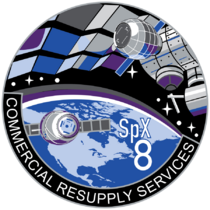 NASA SpX-8 mission patch | |
SpaceX CRS-8, also known as SpX-8,[5] was a Commercial Resupply Service mission to the International Space Station (ISS) which was launched on April 8, 2016, at 20:43 UTC. It was the 23rd flight of a Falcon 9 rocket, the tenth flight of a Dragon cargo spacecraft and the eighth operational mission contracted to SpaceX by NASA under the Commercial Resupply Services program.[6] The capsule carried over 3,100 kilograms (6,800 lb) of cargo to the ISS including the Bigelow Expandable Activity Module (BEAM), a prototype inflatable space habitat delivered in the vehicle's trunk, which was attached to the station and, as of May 2022, is expected to remain so for five more full years of in-orbit viability tests.[7]
After boosting the payload on its orbital trajectory, the rocket's first stage re-entered the denser layers of the atmosphere and landed vertically on the ocean landing platform Of Course I Still Love You nine minutes after liftoff, achieving a long-sought-after milestone in SpaceX reusable launch system development program.[8]
The recovered Falcon 9 first stage (B1021) from this mission became the first one to be flown again, launching the SES-10 satellite on March 30, 2017.[9]
Launch schedule history
The launch was initially scheduled by NASA to occur no earlier than September 2, 2015. The launch date went under review pending the outcome of the analysis of the failure of the Falcon 9 launch vehicle in SpaceX CRS-7, a June 2015 flight. The return-to-flight (RTF) project included additional improvements.[10]
With additional manifest changes announced by SpaceX in mid-October, CRS-8 was scheduled to be the third launch of the upgraded Falcon 9 Full Thrust rocket.[11] By March 2016, the launch date was set to April 8, 2016, with a backup launch window the next day.
The spacecraft was finally launched on schedule, at 20:43 UTC on April 8, 2016. The rocket first stage separated around 2 minutes 40 seconds after liftoff, and the second stage separated around ten minutes 30 seconds after liftoff.
Primary payload
NASA has contracted for the CRS-8 mission from SpaceX and therefore determines the orbital parameters for the primary payload – the Dragon space capsule.
The mission delivered 3,136 kilograms (6,914 lb) of supplies, experiments, and hardware to the ISS. These include the station's first expandable module, called the Bigelow Expandable Activity Module (BEAM), which is expected to remain on the station for at least five more full years of observation and testing.[6][12] Also delivered in the Dragon were sixteen Flock 2d 3U CubeSats for the Earth-observing Flock constellation, built and operated by Planet Labs, which will be deployed by the NanoRacks CubeSat Deployer.[13]
After splashdown, the mission returned more than 3,700 lb (1,700 kg) of cargo from the station back to Earth.[3]
First stage landing
After placing the CRS-8 cargo on its way to the International Space Station, the first stage of the Falcon 9 rocket conducted an experimental boostback and re-entry maneuver over the Atlantic Ocean. Nine minutes after liftoff, at 20:52:10 UTC, the booster landed vertically on the autonomous spaceport drone ship Of Course I Still Love You, 300 kilometers (190 mi) from the Florida coastline, achieving a long-sought-after milestone for the SpaceX reusable launch system development program.[8]
This was the second successful landing achieved by a SpaceX orbital launch vehicle and the first vertical landing by any organization on a floating platform. SpaceX first landed a Falcon 9 on solid ground at Cape Canaveral with flight 20 on December 22, 2015.[8]
Port arrival
The drone ship carried the stage to Port Canaveral, Florida, arriving on April 12, 2016 (UTC),[14] where it was offloaded. SpaceX plans to keep this first stage in Cape Canaveral and conduct a series of test fires to ensure that the vehicle is ready for a future operational mission.[15] According to SpaceX CEO Elon Musk, the rocket will likely be test-fired at Kennedy Space Center Launch Complex 39.[16] Musk noted that assuming the test fires went well, the stage would likely be reflown for a mission in June 2016.[16]
First stage reflight
The first stage of the CRS-8 launch was selected to be reflown first,[17] in early 2017.[18][19] Additional tests were conducted prior to SpaceX certifying the stage's suitability for reuse on subsequent launch.[20] On January 31, 2017, SpaceX posted a photo of a static fire test of this stage in Texas.[21] It was launched again on March 30, 2017, as part of Falcon 9 Flight 32 carrying the SES-10 communications satellite. The stage was also recovered a second time after landing on the drone ship Of Course I Still Love You.[22]
As part of a multi-month multi-vehicle test process to reuse Falcon 9 boosters, another first stage — from flight 24 which carried JCSAT-14 — was designated a "reference vehicle" for further testing, because it encountered "extreme temperatures during its reentry into Earth atmosphere" in May 2016 from a more energetic GTO trajectory. This booster underwent a series of tests, including a 150-second full-duration engine firing which was completed on July 28, 2016.[20]
Gallery
See also
- List of Falcon 9 launches
References
- ↑ Foust, Jeff (September 6, 2015). "SpaceX Will Debut Upgraded Falcon 9 Rocket on Return to Flight Mission". Space.com. http://www.space.com/30431-spacex-falcon-9-rocket-upgrades-next-launch.html.
- ↑ 2.0 2.1 "Dragon Splashdown" (Press release). SpaceX. May 11, 2016.
- ↑ 3.0 3.1 3.2 3.3 Gebhardt, Chris (May 11, 2016). "CRS-8 Dragon completes ISS mission, splashes down in Pacific". NASA Spaceflight. https://www.nasaspaceflight.com/2016/05/crs-8-dragon-iss-mission-splashdown-pacific/.
- ↑ "May 2016 – Page 13 – ISS On-Orbit Status Report" (in en-US). May 11, 2016. https://blogs.nasa.gov/stationreport/2016/05/page/13/.
- ↑ Hartman, Daniel W. (July 2014). "Status of the ISS USOS". NASA Advisory Council HEOMD Committee. http://www.nasa.gov/sites/default/files/files/ISS-USOS-Program-Status-NAC-Public-July-2014.pdf.
- ↑ 6.0 6.1 "NASA to Test Bigelow Expandable Module on Space Station". NASA. January 16, 2013. http://www.nasa.gov/mission_pages/station/news/beam_feature.html.
- ↑ Thomson, Iain (March 14, 2015). "SpaceX to deliver Bigelow blow-up job to ISS astronauts". The Register. https://www.theregister.co.uk/2015/03/14/spacex_inflatable_bigelow_iss/.
- ↑ 8.0 8.1 8.2 Drake, Nadia (April 8, 2016). "SpaceX Rocket Makes Spectacular Landing on Drone Ship". National Geographic. http://phenomena.nationalgeographic.com/2016/04/08/spacex-rocket-makes-spectacular-landing-on-drone-ship/. "To space and back, in less than nine minutes? Hello, future."
- ↑ Grush, Loren (March 30, 2017). "SpaceX makes aerospace history with successful launch and landing of a used rocket". The Verge. https://www.theverge.com/2017/3/30/15117096/spacex-launch-reusable-rocket-success-falcon-9-landing.
- ↑ Bergin, Chris (September 7, 2015). "SpaceX conducts additional Falcon 9 improvements ahead of busy schedule". NASA Spaceflight. http://www.nasaspaceflight.com/2015/09/spacex-conducts-falcon-9-improvements-busy-schedule/.
- ↑ de Selding, Peter B. (October 16, 2015). "SpaceX Changes its Falcon 9 Return-to-flight Plans". SpaceNews. http://spacenews.com/spacex-changes-its-falcon-9-return-to-flight-plans/.
- ↑ Siceloff, Steven (March 18, 2016). "SpaceX-8 Experiments to Cover Habitat, Drug Research". NASA. https://blogs.nasa.gov/spacex/2016/03/18/spacex-8-experiments-to-cover-habitat-drug-research/.
- ↑ Krebs, Gunter Dirk (January 16, 2016). "The Flock Earth observing constellation". Gunter's Space Page. http://space.skyrocket.de/doc_sdat/flock-1.htm.
- ↑ Dean, James (April 12, 2016). "SpaceX Falcon 9 rocket arrives at Port Canaveral". http://www.floridatoday.com/story/tech/science/space/2016/04/11/port-awaits-return-spacex-rocket/82896330/.
- ↑ Bergin, Chris (April 12, 2016). "Falcon 9 first stage sails into Port Canaveral atop ASDS – ahead of big plans". NASA Spaceflight. https://www.nasaspaceflight.com/2016/04/falcon-9-first-stage-port-canaveral-asds-big-plans/.
- ↑ 16.0 16.1 Clark, Stephen (April 12, 2016). "SpaceX's Falcon 9 rocket returns to port". Spaceflight Now. http://spaceflightnow.com/2016/04/12/spacexs-falcon-9-rocket-returns-to-port/.
- ↑ Henry, Caleb (August 30, 2016). "SES Becomes First Reusable Rocket Customer for SpaceX". Via Satellite. http://www.satellitetoday.com/nextspace/2016/08/30/ses-becomes-first-reusable-rocket-customer-spacex/.
- ↑ Clark, Stephen (January 22, 2017). "Launch Schedule". Spaceflight Now. http://spaceflightnow.com/launch-schedule/.
- ↑ Peter B. de Selding [@pbdes] (October 28, 2016). "CFO says SES-10 tentatively set for January launch on SpaceX Falcon 9.". https://twitter.com/pbdes/status/791915233677758465.
- ↑ 20.0 20.1 Berger, Eric (July 29, 2016). "SpaceX takes another step toward reusability with 150-second engine test". Ars Technica. https://arstechnica.com/science/2016/07/burn-baby-burn-spacex-test-fires-a-rocket-previously-flown-in-may/.
- ↑ "Prepping to fly again". Twitter.com. SpaceX. January 31, 2017. https://twitter.com/SpaceX/status/826598817864761344.
- ↑ Graham, William (March 30, 2017). "SpaceX conducts historic Falcon 9 re-flight with SES-10 – Lands booster again". NASASpaceFlight.com. https://www.nasaspaceflight.com/2017/03/spacex-historic-falcon-9-re-flight-ses-10/.
External links
- CRS-8 Mission Overview at NASA.gov
- CRS-8 Press Kit at SpaceX.com
 |
